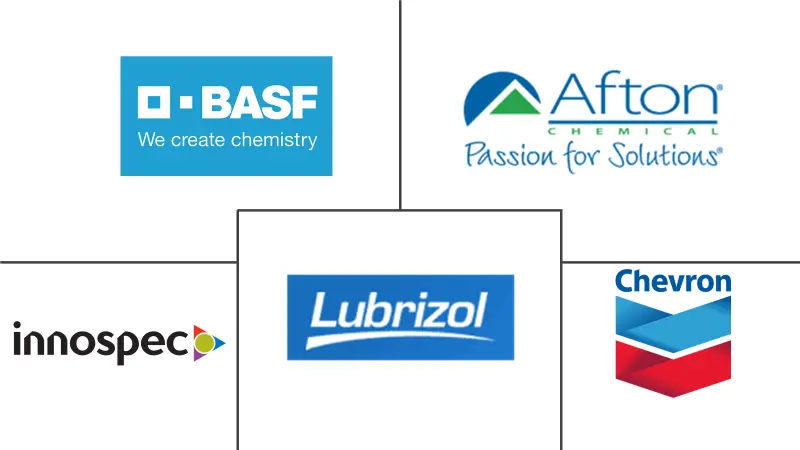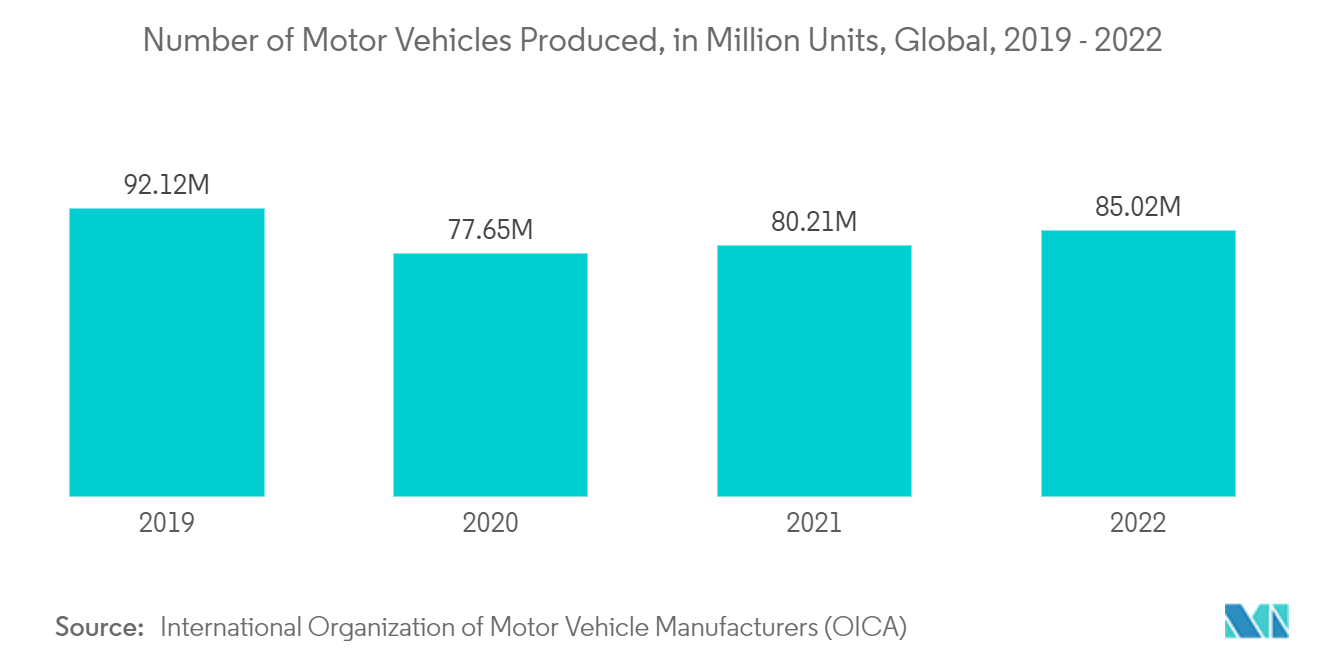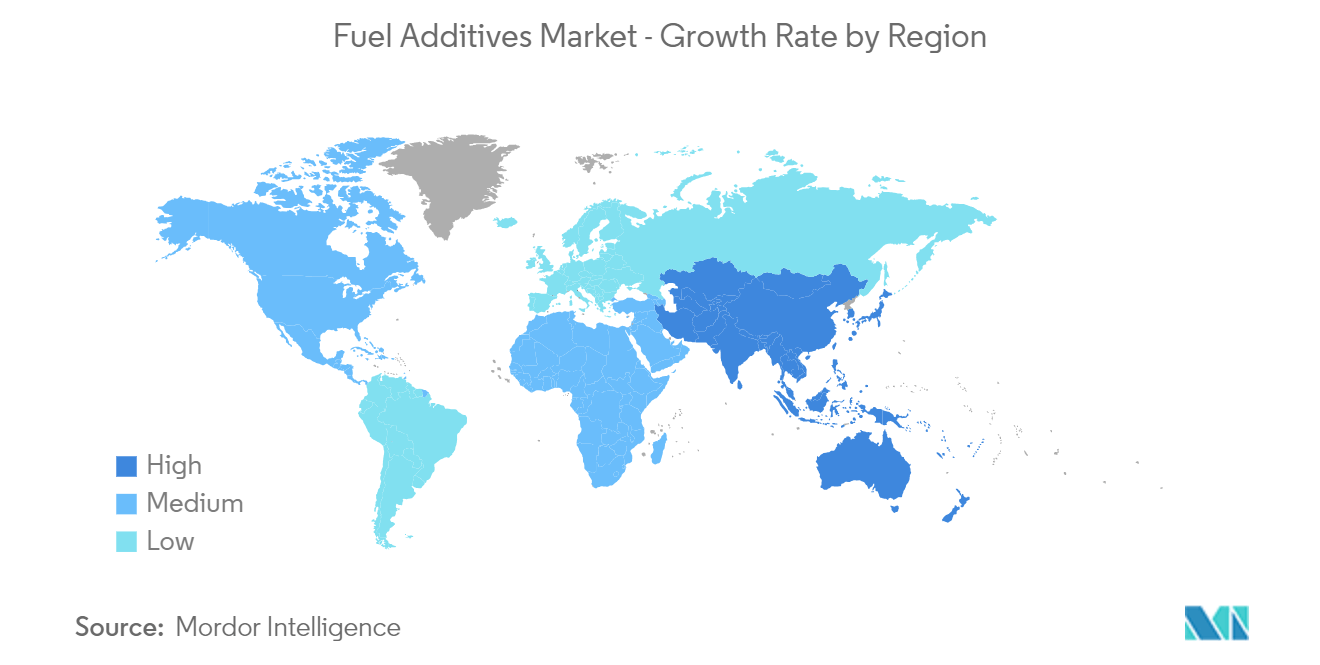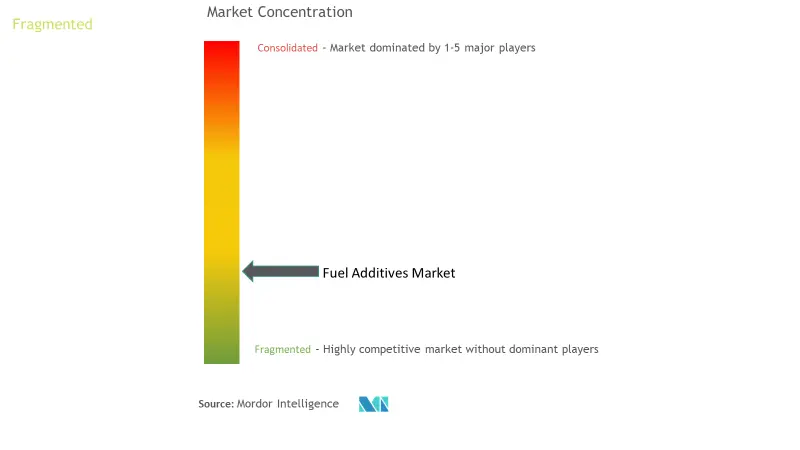Fuel Additives Market Size

| Study Period | 2019 - 2029 |
| Market Volume (2024) | 1.94 Million tons |
| Market Volume (2029) | 2.48 Million tons |
| CAGR (2024 - 2029) | 5.09 % |
| Fastest Growing Market | Asia Pacific |
| Largest Market | North America |
| Market Concentration | Low |
Major Players
*Disclaimer: Major Players sorted in no particular order |
Fuel Additives Market Analysis
The Fuel Additives Market size is estimated at 1.94 Million tons in 2024, and is expected to reach 2.48 Million tons by 2029, growing at a CAGR of 5.09% during the forecast period (2024-2029).
The COVID-19 pandemic negatively impacted the market. This was because of the shutdown of manufacturing facilities and plants due to the lockdown and restrictions. Supply chain and transportation disruptions further created hindrances for the market. However, the industry witnessed a recovery in 2021, thus rebounding the demand for the market studied.
- Over the medium term, the enactment of stringent environmental regulations and the degrading quality of crude oil are some of the factors driving the growth of the market studied.
- On the flip side, increasing demand for battery electric vehicles (BEVs) in countries such as the United States, China, and Germany and high cost of R&D activities may hamper the market's growth during the forecast period.
- However, the accelerating demand for ultra-low-sulfur diesel (ULSD) is likely to act as an opportunity for market growth in the future.
Fuel Additives Market Trends
Gasoline to Dominate the Market Studied
- Gasoline is the primary product made from petroleum. The major portion of the gasoline used in automotive and aviation is cracked gasoline obtained through the thermal or catalytic cracking of the heavier oil fractions.
- Gasoline additives that increase octane number are also considered antiknock additives as they can increase the antiknock capability of the fuel. The additives in this category mainly include ethers, alcohols, esters, organometallic compounds, and others.
- For light-duty vehicles, gasoline engines play the role of major power source. Gasoline additives include hybrid compound blends, oxygenates, antioxidants, antiknock agents, lead scavengers, and fuel dyes, among others.
- According to the US Energy Information Administration, in August 2023, the total gasoline production in the United States increased to 290 thousand barrels from 130 thousand barrels reported in the previous month.
- Three main grades of gasoline are sold at retail gasoline refueling stations: Regular, Midgrade, and Premium. In 2022, about 134.55 billion gallons of finished motor gasoline were consumed in the United States, an average of about 369 million gallons per day (or about 8.78 million barrels per day).
- As per the US Energy Information Administration, in 2022, the global production of oil and other petroleum liquids averaged 100.1 million barrels per day (b/d) and is expected to rise to 101.8 million barrels per day in 2023.
- The top five oil-producing nations in 2022 were the United States, Saudi Arabia, Russia, Canada, and China. The United States topped the list with a production of 18,875,000 barrels per day (bpd). Saudi Arabia came in second with an output of 10,835,000 BPD and possesses 17% of the total proven petroleum reserves on a global scale.
- Thus, owing to the aforementioned factors, gasoline-related applications of fuel additives are likely to account for the highest market share during the forecast period.

North America to Dominate the Market
- The United States dominated the fuel additive market in the North American region. The United States is one of the fastest-emerging economies and has become one of the biggest production houses in the world today. The country's manufacturing sector is one of the major contributors to the country's economy.
- In the United States, jet/kerosene fuel witnessed a hike in consumption owing to the rising demand in the aviation industry. In 2022, the country consumed 1562 thousand barrels per day, which increased by 13.5% compared to 1376 thousand barrels per day in the previous year.
- Moreover, fuel oil experienced a hike in consumption by 9.2% to 343 thousand barrels per day in 2022 compared to 314 thousand barrels per day in 2021.
- According to OICA, the United States is the second-largest automotive manufacturer after China and produced 10.06 million vehicles in 2022, registering a growth of 10% compared to the production in 2021. The country produced 1.75 million cars and 8.3 million commercial vehicles in 2022.
- In March 2023, new vehicle sales totaled 1,384,676 units, a 19.2% increase from February 2023 and a 9.4% increase from March 2022.
- Further, according to the Automotive Industries Association of Canada, new motor vehicle sales for the months of January 2023, February 2023, and March 2023 are 103,380; 109,781, and 150,956 units, respectively. In April 2023, an estimated 144,069 units were sold in Canada, slightly less than the March 2023 total and a 2.3% increase over April 2022.
- Moreover, the United States has one of the biggest aviation markets in the entire world. More people are transported by US airplanes than by airlines from any other nation, and around half of the top 10 revenue-generating airlines in the world are based in the United States. Further, according to the Federal Aviation Administration (FAA), the general aviation fleet in the United States had expanded to 204,590 aircraft in 2022. Also, the US commercial aviation fleet had roughly 935 of these aircraft as of 2022. This is expected to increase the market demand from multiple applications in the aerospace industry.
- All these factors, in turn, have an impact on the consumption of fuel additives during the forecast period.

Fuel Additives Industry Overview
The fuel additives market is fragmented in nature. The major players (not in any particular order) include Afton Chemicals, The Lubrizol Corporation, Innospec, Chevron Corporation, and BASF SE, among others.
Fuel Additives Market Leaders
-
Afton Chemical
-
The Lubrizol Corporation
-
BASF SE
-
Chevron corporation
-
Innospec
*Disclaimer: Major Players sorted in no particular order

Fuel Additives Market News
- April 2022: Afton Chemical's Greenclean 3 is an advancement in diesel fuel detergent technology launched in North America. This powerful, creative technology will continue to improve the performance of heavy-duty fleets and off-road vehicles equipped with cutting-edge engine technology and pollution control systems.
- March 2022: Afton Chemical Corporation completed the expansion of its phase 3 Singapore Chemical Additive Manufacturing Facility. The aim of this expansion was to provide fuel Performance Additives (GPA) blending capabilities. This growth helped the company to focus on providing effective localized supply chain solutions to its Asian customers.
Fuel Additives Market Report - Table of Contents
1. INTRODUCTION
1.1 Study Assumptions
1.2 Scope of the Study
2. RESEARCH METHODOLOGY
3. EXECUTIVE SUMMARY
4. MARKET DYNAMICS
4.1 Drivers
4.1.1 Enactment of Stringent Environmental Regulations
4.1.2 Degrading Quality of Crude Oil
4.2 Restraints
4.2.1 Increasing Demand for Battery Electric Vehicles (BEVs)
4.2.2 High Costs of R&D Activities
4.3 Industry Value Chain Analysis
4.4 Porter's Five Forces Analysis
4.4.1 Bargaining Power of Suppliers
4.4.2 Bargaining Power of Buyers
4.4.3 Threat of New Entrants
4.4.4 Threat of Substitute Products and Services
4.4.5 Degree of Competition
5. MARKET SEGMENTATION (Market Size by Volume)
5.1 Product Type
5.1.1 Deposit Control
5.1.2 Cetane Improvers
5.1.3 Lubricity Additives
5.1.4 Antioxidants
5.1.5 Anticorrosion
5.1.6 Cold Flow Improvers
5.1.7 Antiknock Agents
5.1.8 Other Product Types
5.2 Application
5.2.1 Diesel
5.2.2 Gasoline
5.2.3 Jet Fuel
5.2.4 Other Applications
5.3 Geography
5.3.1 Asia-Pacific
5.3.1.1 China
5.3.1.2 India
5.3.1.3 Japan
5.3.1.4 South Korea
5.3.1.5 Rest of Asia-Pacific
5.3.2 North America
5.3.2.1 United States
5.3.2.2 Canada
5.3.3 Europe
5.3.3.1 Germany
5.3.3.2 France
5.3.3.3 United Kingdom
5.3.3.4 Italy
5.3.3.5 Rest of Europe
5.3.4 South America
5.3.4.1 Brazil
5.3.4.2 Mexico
5.3.4.3 Argentina
5.3.4.4 Rest of South America
5.3.5 Middle-East and Africa
5.3.5.1 Saudi Arabia
5.3.5.2 South Africa
5.3.5.3 Rest of Middle-East and Africa
6. COMPETITIVE LANDSCAPE
6.1 Mergers, Acquisitions, Joint Ventures, Collaborations, and Agreements
6.2 Market Share (%)**/Ranking Analysis
6.3 Strategies Adopted by Leading Players
6.4 Company Profiles
6.4.1 Afton Chemical
6.4.2 Baker Hughes Company
6.4.3 BASF SE
6.4.4 Cargill Incorporated
6.4.5 Chevron Corporation
6.4.6 Clariant
6.4.7 Dorf Ketal Chemicals
6.4.8 Evonik Industries AG
6.4.9 Exxon Mobil corporation
6.4.10 Infineum International Limited
6.4.11 Innospec
6.4.12 Lanxess
6.4.13 The Lubrizol Corporation
6.4.14 TotalEnergies SE
- *List Not Exhaustive
7. MARKET OPPORTUNITIES AND FUTURE TRENDS
7.1 Accelerating Demand for Ultra-low-sulfur Diesel (ULSD)
Fuel Additives Industry Segmentation
Fuel additives are compounds that are designed to improve the quality and efficiency of fuels. Fuel additives are added to improve performance, flowability, corrosion resistance, clean burning, and many other properties.
The fuel additives market is segmented based on product type, application, and geography. The market is segmented by product type into deposit control, cetane improvers, lubricity additives, antioxidants, anti-corrosion, cold flow improvers, antiknock agents, and other product types. The market is segmented by application into diesel, gasoline, jet fuel, and other applications. On the basis of geography, the market is categorized into Asia-Pacific, North America, Europe, South America, the Middle East, and Africa. The report also covers the market size and forecasts for fuel additives in 15 countries across major regions. For each segment, the market sizing and forecasts have been done based on volume (Tons).
| Product Type | |
| Deposit Control | |
| Cetane Improvers | |
| Lubricity Additives | |
| Antioxidants | |
| Anticorrosion | |
| Cold Flow Improvers | |
| Antiknock Agents | |
| Other Product Types |
| Application | |
| Diesel | |
| Gasoline | |
| Jet Fuel | |
| Other Applications |
| Geography | |||||||
| |||||||
| |||||||
| |||||||
| |||||||
|
Fuel Additives Market Research FAQs
How big is the Fuel Additives Market?
The Fuel Additives Market size is expected to reach 1.94 million tons in 2024 and grow at a CAGR of 5.09% to reach 2.48 million tons by 2029.
What is the current Fuel Additives Market size?
In 2024, the Fuel Additives Market size is expected to reach 1.94 million tons.
Who are the key players in Fuel Additives Market?
Afton Chemical, The Lubrizol Corporation, BASF SE, Chevron corporation and Innospec are the major companies operating in the Fuel Additives Market.
Which is the fastest growing region in Fuel Additives Market?
Asia Pacific is estimated to grow at the highest CAGR over the forecast period (2024-2029).
Which region has the biggest share in Fuel Additives Market?
In 2024, the North America accounts for the largest market share in Fuel Additives Market.
What opportunities exist in the Fuel Additives Market?
The opportunities that exist in the Fuel Additives Market are a) Increasing demand for ultra-low sulfur diesel (ULSD) b) Introduction of newer emissions control technologies
What is the leading segment in the Fuel Additives Market?
The Gasoline segment is the leading segment in the Fuel Additives Market.
Fuel Additive Industry Report
The global fuel additives market is poised for significant growth, driven by stringent governmental regulations aimed at reducing harmful emissions and enhancing fuel efficiency across various applications such as diesel, gasoline, and aviation fuel. The market is segmented by type, with lubricity improvers experiencing rapid growth due to the increasing demand for ultra-low sulfur diesel, which necessitates additives to maintain fuel efficiency and engine life. Geographically, North America holds a substantial market share, while APAC is noted for its rapid growth due to high economic development and rising vehicle production. The market dynamics are influenced by the demand for cleaner fuels, the degradation of crude oil quality, and shifts in the automotive industry towards hybrid and electric vehicles, which may impact the demand for traditional fuel additives as well as the battery additives market. Innovations and regulatory frameworks continue to shape the market's trajectory, affecting both fuel additives brands and broader market trends. For detailed statistics, market share, size, and revenue growth insights, access a sample of the industry analysis as a free report PDF download from Mordor Intelligence™ Industry Reports.



